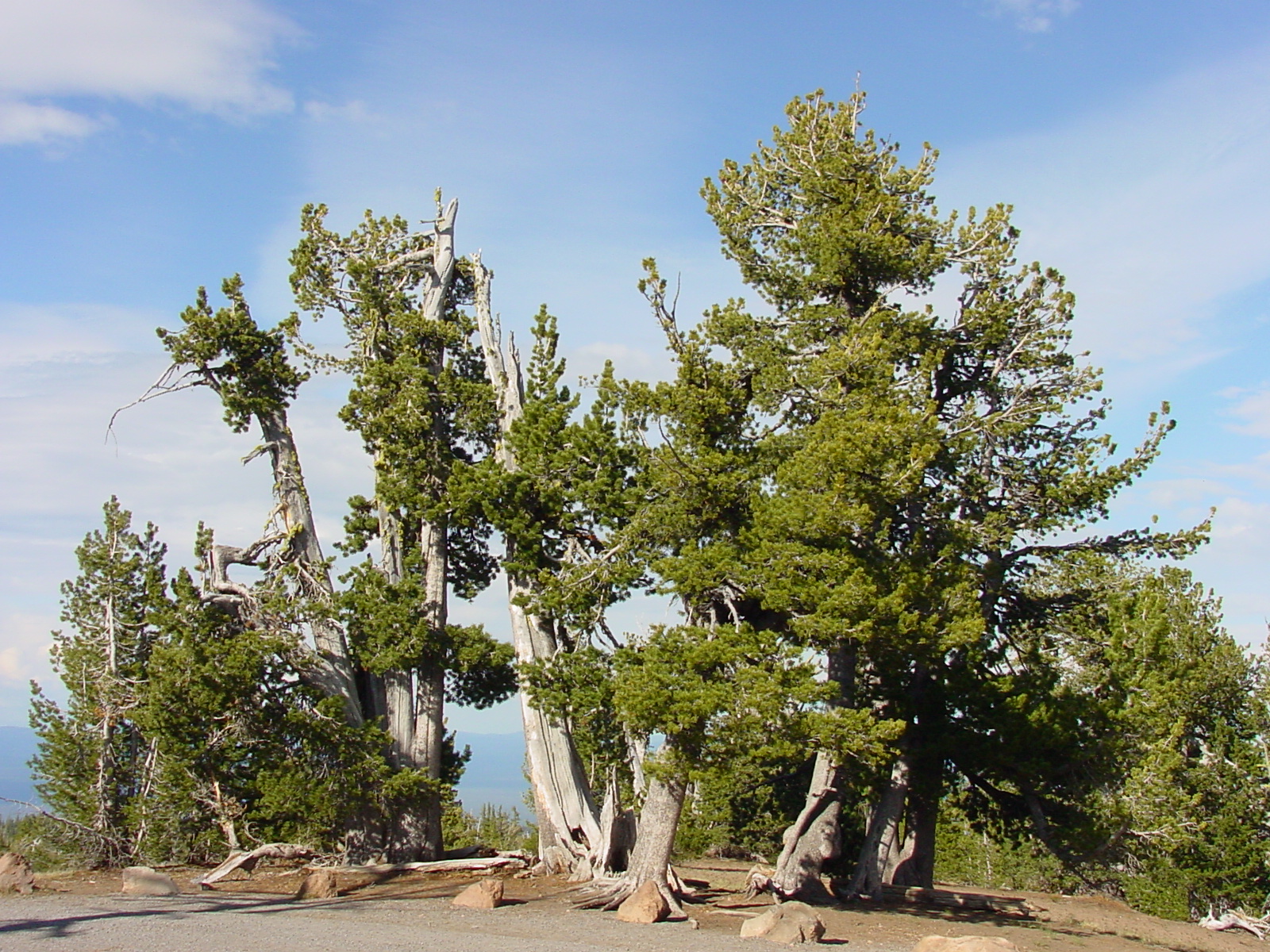- Whitebark Pine
Taxobox
name = Whitebark Pine
status = VU
status_system = iucn2.3

image_width = 240px
image_caption = A stand of Whitebark Pines
regnum =Plant ae
divisio =Pinophyta
classis = Pinopsida
ordo =Pinales
familia =Pinaceae
genus = "Pinus"
subgenus = "Strobus"
species = "P. albicaulis"
binomial = "Pinus albicaulis"
binomial_authority = Engelm.The Whitebark Pine ("Pinus albicaulis"; family
Pinaceae ) occurs in the mountains of the WesternUnited States andCanada , specifically thesubalpine areas of the Sierra Nevada, theCascade Range , thePacific Coast Ranges , and the northernRocky Mountains (including theGreater Yellowstone Ecosystem ). The Whitebark Pine is typically the highest-elevation pine tree of these mountains, marking thetree line . Thus, they are often found as "krummholz", trees dwarfed by exposure and growing close to the ground. In more favourable conditions, trees may grow to 20 m in height, although some can reach up to 27 m.Whitebark Pine is a member of the white pine group, "
Pinus " subgenus "Strobus ", section "Strobus " and like all members of that group, the leaves ('needles') are in fascicles (bundles) of five, with a deciduous sheath. This distinguishes Whitebark Pine and relatives from theLodgepole Pine , with two needles per fascicle, andPonderosa Pine andJeffrey Pine , which both have three per fascicle; these three all also have a persistent sheath at the base of each fascicle.Distinguishing Whitebark Pine from the related
Limber Pine , also a white pine, is much more difficult, and requires seed or pollen cones. In Whitebark Pine, the cones are 4-7 cm long, dark purple when immature, and do not open on drying, but the scales easily break when they are removed byClark's Nutcracker (see below) to harvest the seeds. In Limber Pine, the cones are 6-12 cm long, green when immature, and open to release the seeds; the scales are not fragile. Whitebark Pines almost rarely has intact old cones lying under them, whereas Limber Pines usually do. The pollen cones of Whitebark Pine are scarlet, and yellow in Limber Pine.Whitebark Pine can also be hard to distinguish from
Western White Pine in the absence of cones. However, Whitebark Pine needles are entire (smooth when rubbed gently in either direction), whereas Western White Pine needles are finely serrated (feeling rough when rubbed gently from tip to base). Whitebark Pine needles are also usually shorter, 4-7 cm long, to Western White Pine's 5-10 cm (though note the overlap).The Whitebark Pine is an important source of food for many granivorous birds and small mammals, including most importantly the
Clark's Nutcracker , the major seed disperser of the pine. Clark's Nutcrackers each cache about 30,000 to 100,000 each year in small, widely scattered caches usually under 2 to 3 cm of soil or gravelly substrate. Nutcrackers retrieve these seed caches during times of food scarcity and to feed their young. Cache sites selected by nutcrackers are often favorable for germination of seeds and survival of seedlings. Those caches not retrieved by time snow melts contribute to forest regenetation. Consequently,Whitebark Pine often grows in clumps of several trees, originating from a single cache of 2-15 or more seeds.Douglas Squirrel s cut down and store Whitebark Pine cones in their middens.Grizzly Bear s andAmerican Black Bear s often raid squirrel middens for Whitebark Pine seeds, an important pre-hibernation food. Squirrels,Northern Flicker s, andMountain Bluebird s often nest in Whitebark Pines, and elk and Blue Grouse use Whitebark Pine communities as summer habitat.Many stands of Whitebark Pine nearly rangewide are infected with White Pine Blister Rust ("Cronartium ribicola"), a fungal disease that was introduced from
Europe . In the northern Rocky Mountains of the U.S., whitebark Pine mortality in some areas exceeds 90%. Cronartium ribicola occurs in Whitebark Pine to the northern limits of the species in the coastal ranges of British Columbia and the Canadian Rocky Mountains. The blister rust has also devastated the commercially-valuable Western White Pine in these areas, and made serious inroads in Limber Pine populations as well. There is currently no way to stop the spread and effects of blister rust. However, a small number of trees (fewer than 5%) in most populations harbor genetic resistance to blister rust. There have been some restoration efforts by the U.S. Forest Service and National Park Service in the northern Rocky Mountains. Restoration efforts involve harvesting cones from potentially and known resistant Whitebark Pine, growing seedlings, and outplanting seedlings in suitable sites.The threat to Whitebark Pine by blister rust is currently complicated by widespread outbreaks of
Mountain Pine Beetle in the western U.S. and Canada. Since2000 , the climate at high elevations has been warm enough for the beetles to reproduce within Whitebark Pine, often completing their life cycle within one year and enabling their populations to grow exponentially. These higher temperature trends have been attributed by some researchers to global warming. Regardless of cause, the pine beetle upsurge has killed large numbers of Whitebark Pine (nearly 3/4 million in the Greater Yellowstone Ecosystem alone). Mountain pine beetles jeopardize current and future Whitebark Pine restoration efforts, because they are killing trees genetically resistant to white pine blister rust.References
* Listed as Vulnerable (VU A1c v2.3)
*Lanner, R. M. 1996. "Made for each other: a symbiosis of birds and pines". OUP. ISBN 0-19-508903-0
*Logan, J. A., Regniere, J., and Powell, J. A. 2003. Assessing the Impacts of Global Warming on Forest Pest Dynamics. "Frontiers in Ecology and the Environment" 1(3): 130-137.
*Schwandt, J. 2006. Whitebark pine in peril: A case for restoration. USDA, Forest Service, Northern Region, R1-06-28.
*Tomback, D. F., Arno, S. F., and R. E. Keane (eds.) 2001. Whitebark pine communities: ecology and restoration. Island Press, Washington, D. C.External links
* [http://www.pinetum.org/cones/PNStrobus.htm "Pinus albicaulis" cone pic (scroll to foot of page)]
* [http://www.conifers.org/pi/pin/albicaulis.htm Gymnosperm Database: "Pinus albicaulis"]
* [http://plants.usda.gov/java/profile?symbol=PIAL USDA Plants Profile: "Pinus albicaulis"]
* [http://www.efloras.org/object_page.aspx?object_id=6621&flora_id=1 Flora of North America]
* [http://biology.usgs.gov/s+t/SNT/noframe/wm147.htm The Whitebark Pine (at USGS)]
* [http://www.nrmsc.usgs.gov/research/whitebar.htm Whitebark Pine Communities (at USGS)]
* [http://www.whitebarkfound.org Whitebark Pine Ecosystem Foundation]
Wikimedia Foundation. 2010.
